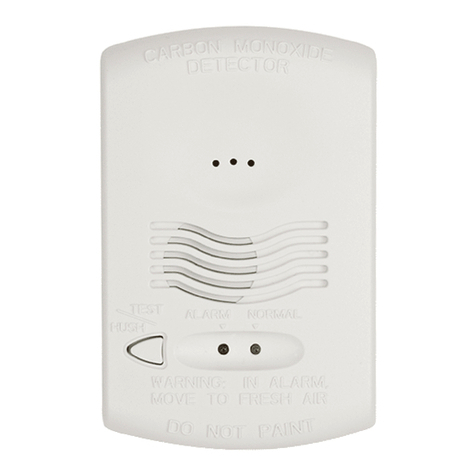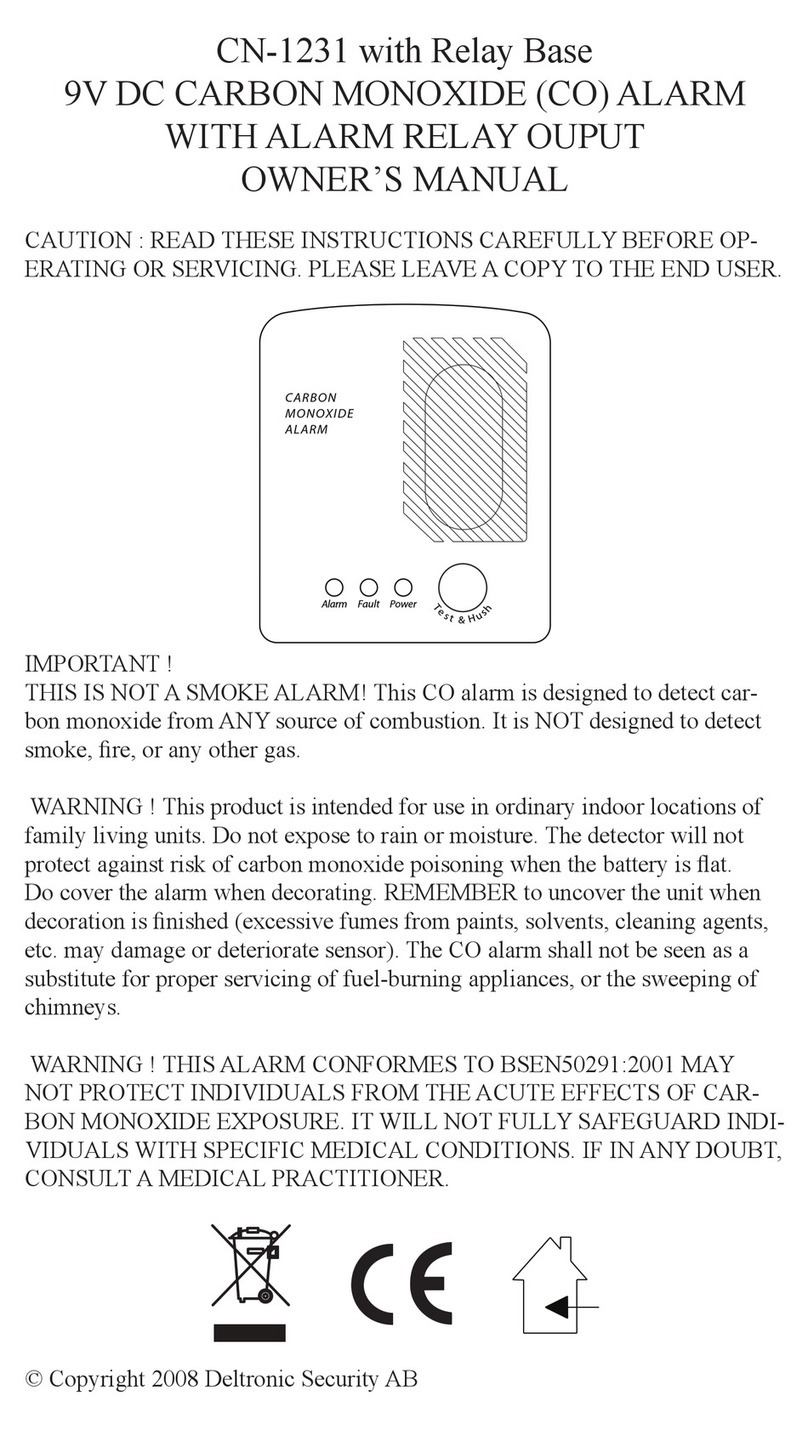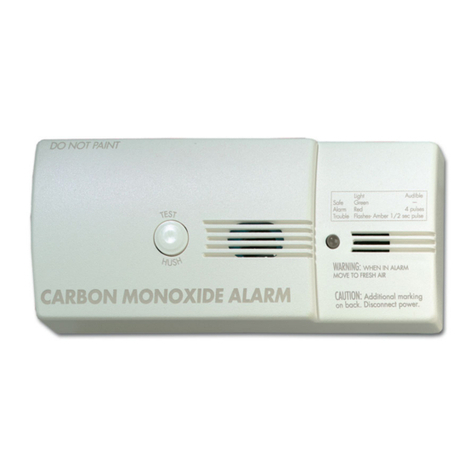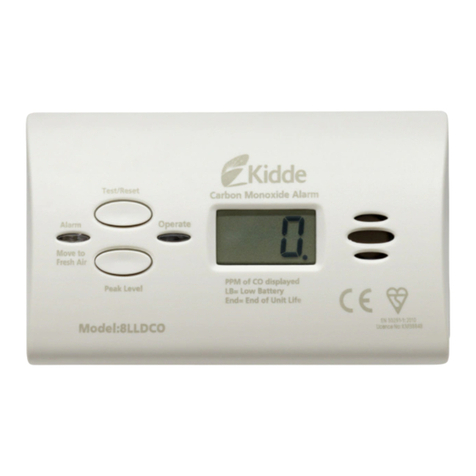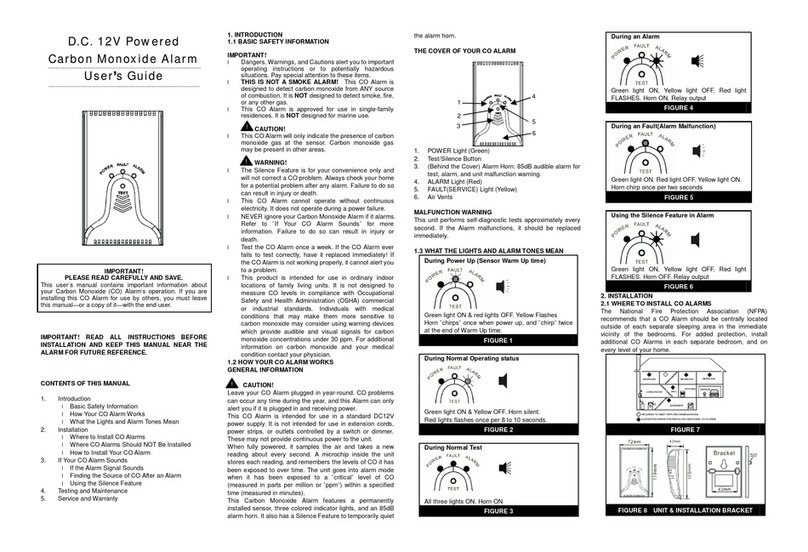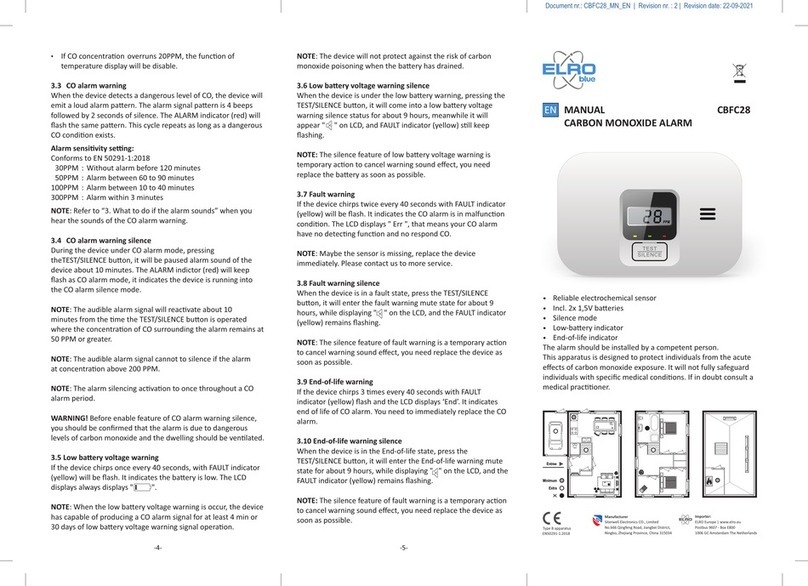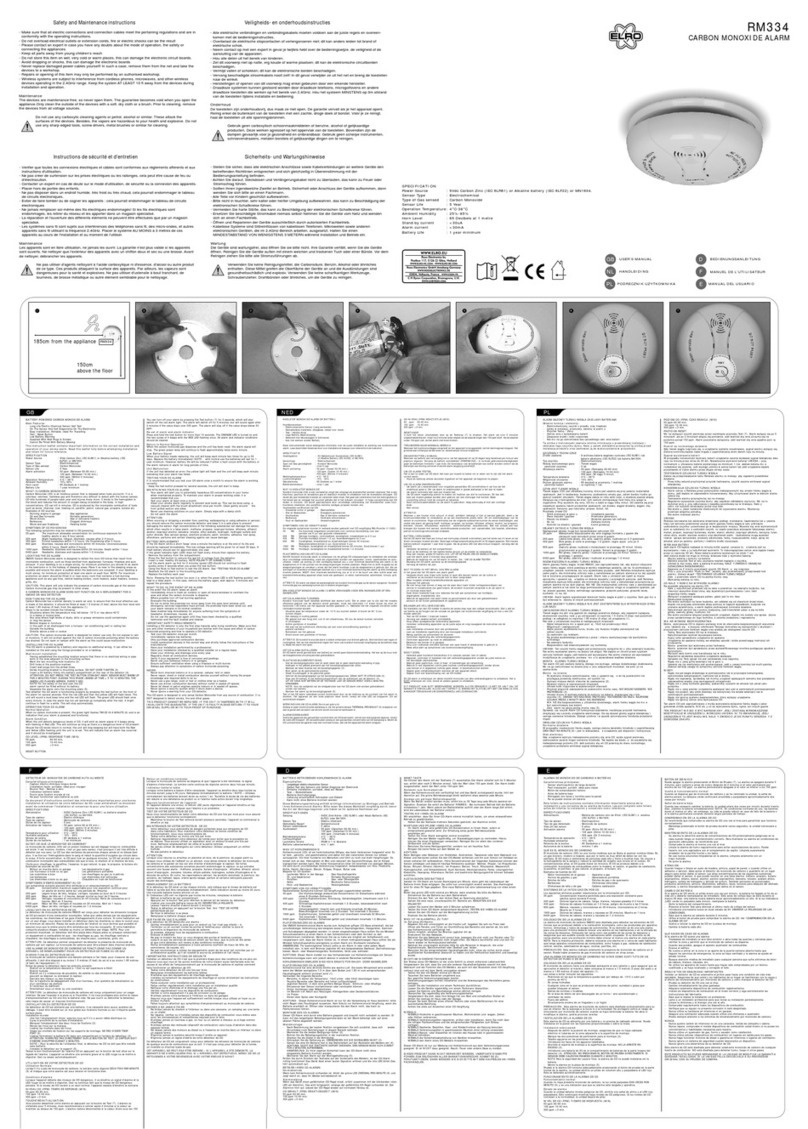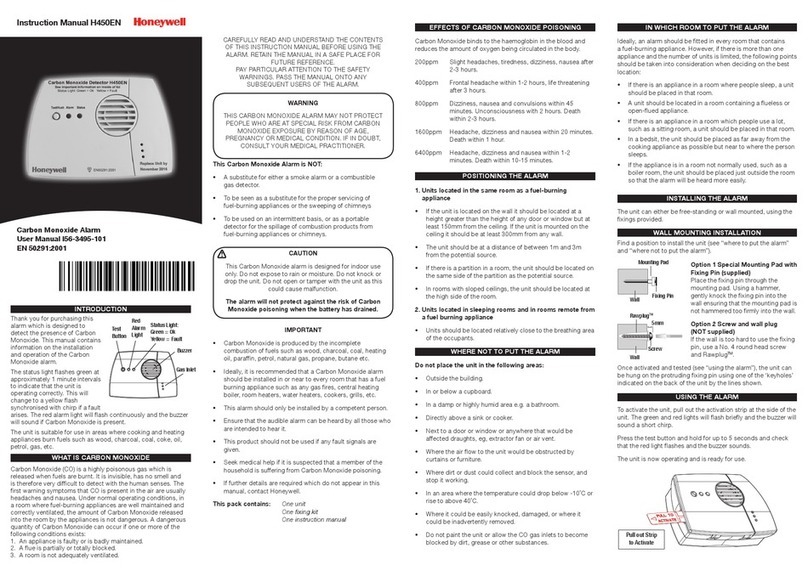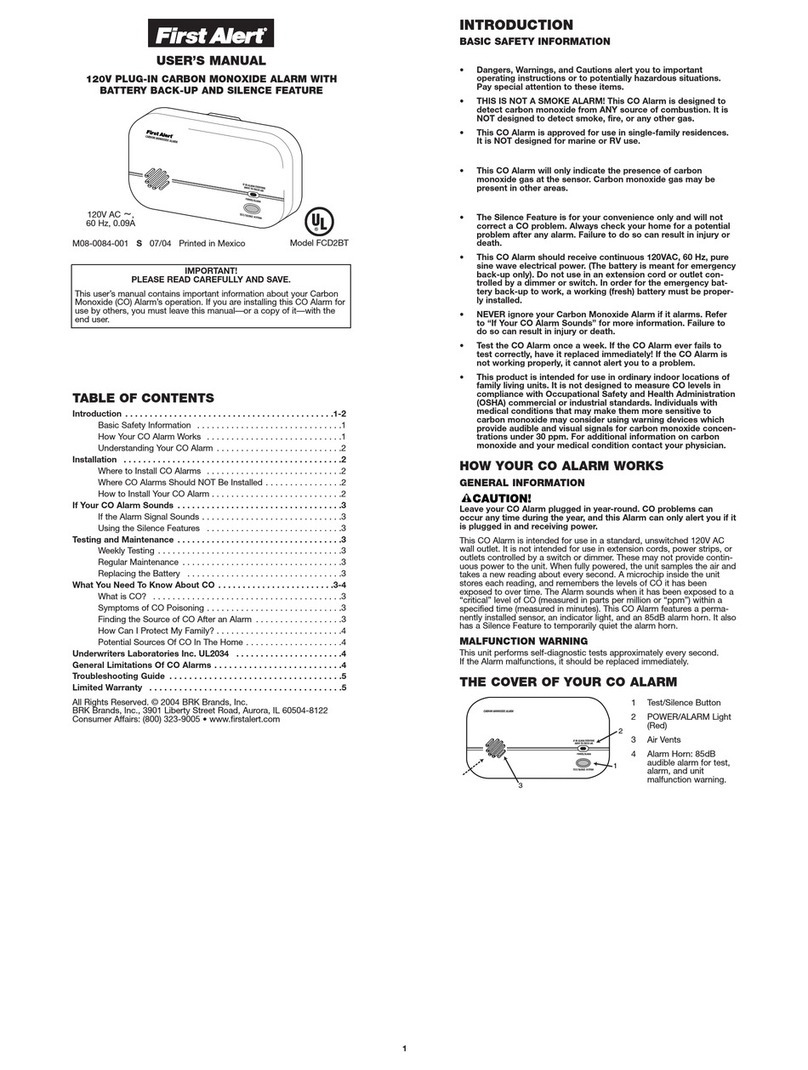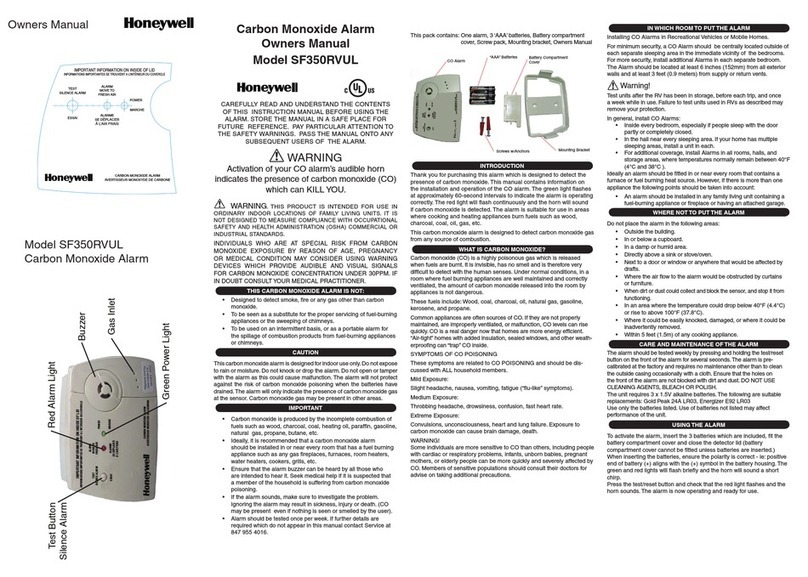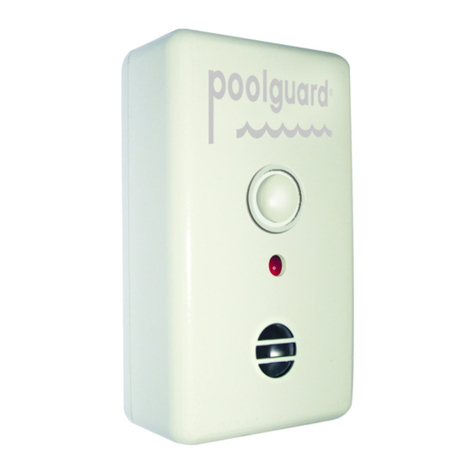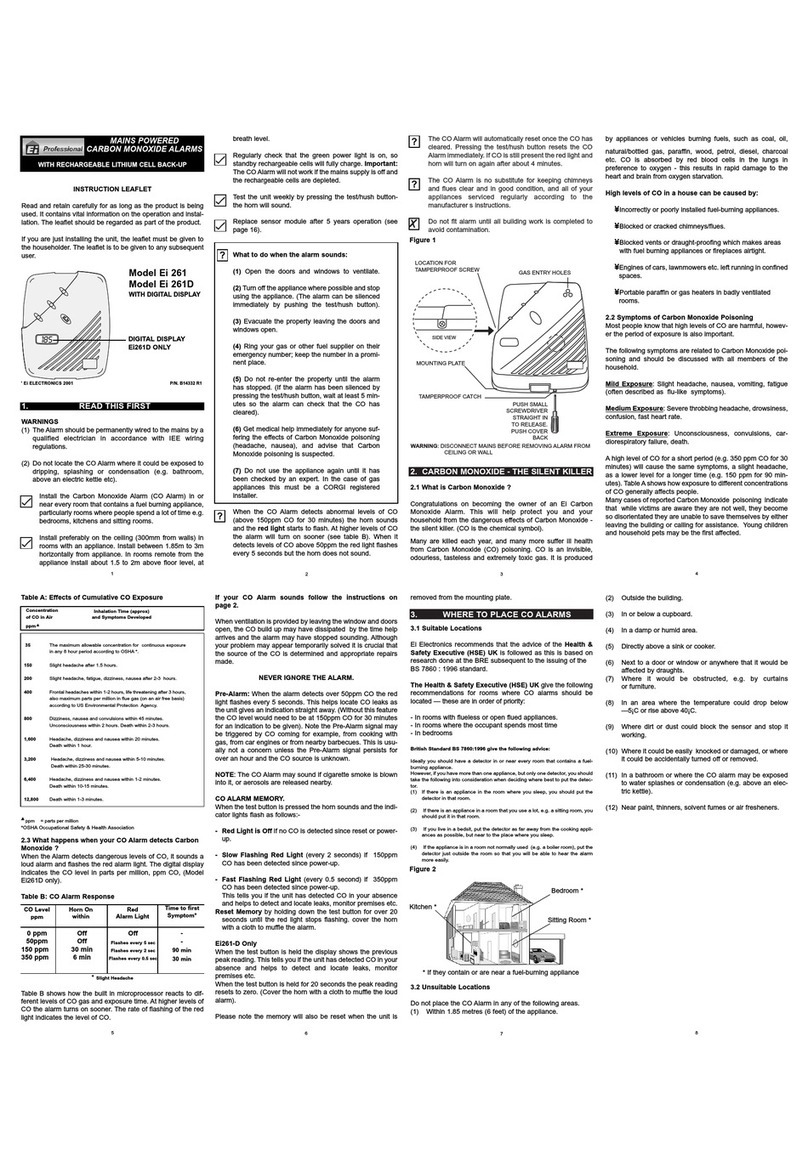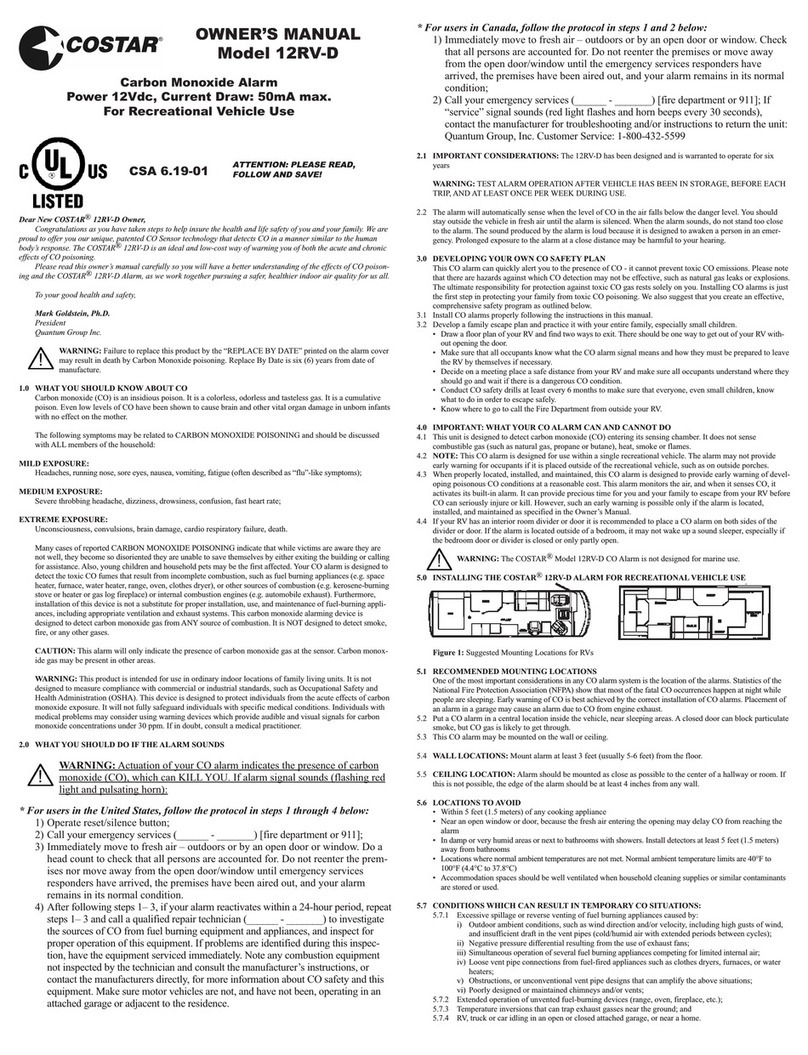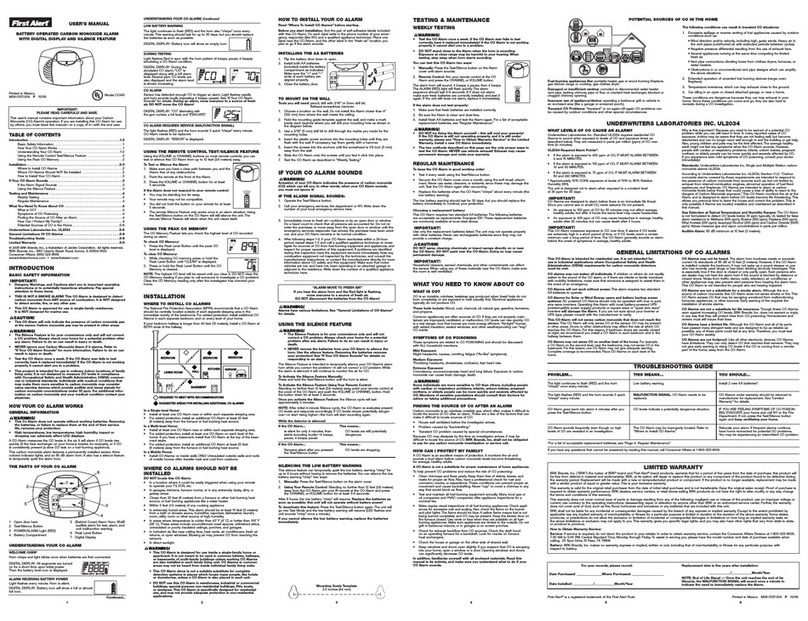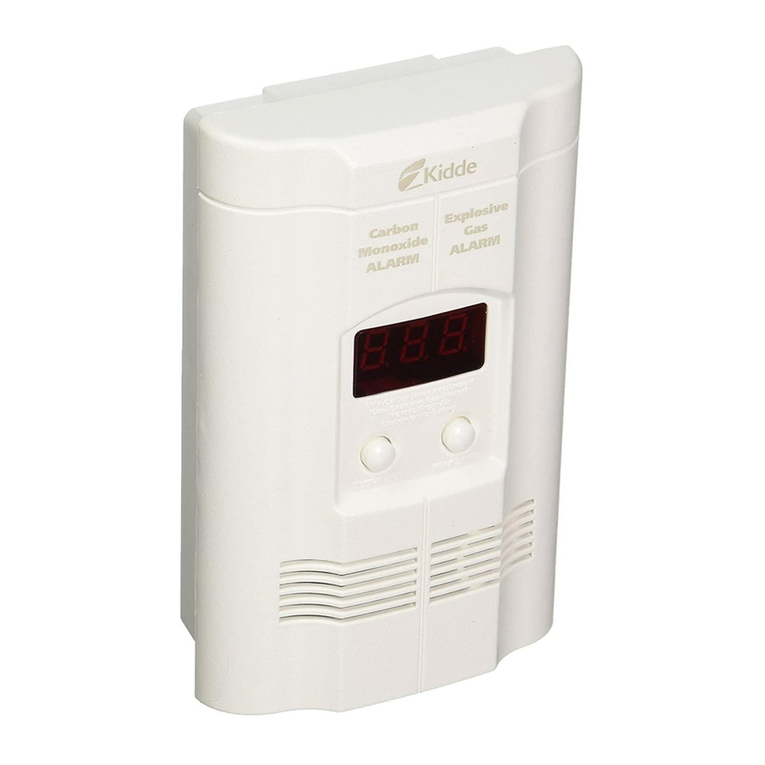BATTERIE-BETRIEBENER KOHLENMONOXID-ALARM BETRIEB IHRES CO-ALARMS NIEMALS:
Normalbetrieb - NIEMALS Holzkohle in geschlossenen Räumen, Wohnmobilen und
Eigenschaften: Wenn kein Kohlenmonoxid vorhanden ist, blinkt die grüne LED jeder 45 Sek. (6) und wagen, Zelten oder Hütten verbrennen.
zeigt damit an, dass Ihr Melder betriebsbereit ist. - NIEMALS Verbrennungsöfen reparieren, prüfen oder installieren, wenn Sie nicht
-Langlebiger elektro-chemischer Sensor über die nötigen Fachkenntnisse und die entsprechenden Fähigkeiten zum
- Einfache Installation Alarmmeldung Einbau verfügen.
- Test- / Rückstelltaste Wenn das Gerät einen gefährlichen CO-Pegel misst, ertönt zusammen mit der - NIEMALS Gasherde, Backöfen, Haar- und Kleidertrockner als Heizung benutzen.
- Batterie-Kontrollanzeige blinkenden roten LED ein Alarmton. Das wird fortgesetzt, solange der gefährliche CO- - NIEMALS Verbrennungsöfen in geschlossenen Räumen ohne Lüftung
- Lieferung einschließlich Schrauben und Dübeln Pegel vorhanden ist. Der Alarmton hört auf, und automatisch in den Standby-modus. verwenden.
- Kann nicht ohne Batterie montiert werden - NIEMALS Benzin- oder Dieselöfen im Inneren des Hauses oder in geschlossenen
CO-GEHALT (PPM) REAKTIONSZEIT (MIN) Räumen betreiben.
Diese Bedienungsanleitung enthält wichtige Informationen zu Montage 50 ppm 60-90 min. - NIEMALS die Sicherheitsabschaltung von Geräten missachten.
und Betrieb Ihres Kohlenmonoxid-Alarms. Bitte lesen Sie dieses Merkblatt 100 ppm 10-40 min. - NIEMALS den Alarm eines CO-Melders missachten.
sorgfältig durch, bevor Sie mit der Montage beginnen und heben es für 300 ppm <3 min.
späteres Nachlesen auf. Dieser CO-Alarm ist nur zur Meldung von Kohlenmonoxid aus dem
Anzeige von geringer Batteriekapazität Verbrennungsprozess geeignet. Er ist NICHT dazu geeignet, Rauch, Feuer oder
SPEZIFIKATIONEN Wenn die Batteri ersetzt werden muss, das Gerät piept und grüne LED-Anzeige zur andere Gase zu melden.
Seisung : DC 4.5V (3xLR6 Alkaline) gleichen zeit (alle 45 Sekunden) für bis zu 7 Tage blinken.
Sensor Typ : Elektro-chemisch Ersetzen Sie sofort die Batterie! HINWEIS - Bei normalem Betrieb hält die Batterie DIESES PRODUKT KANN NICHT REPARIERT WERDEN UNBEFUGTE
Gemeldete Gasart : Kohlenmonoxid mindestens 1 Jahr. Wenn jedoch ein Batteriefehler auftritt oder der Alarm lange Zeit EINGRIFFE FÜHREN ZUM ERLÖSCHEN ALLER GARANTIEANSPRÜCHE.
Sensor Lebensdauer : 5 Jahre ertönt, wird die Lebensdauer der Batterie verkürzt. KOMMT ES ZU FEHLFUNKTIONEN, DANN WENDEN SIE SICH BITTE MIT
Auslösewert : 50 ppm (Zwischen 60-90 min.) DEM KAUFBELEG AN IHREN FACHHÄNDLER.
: 100 ppm (Zwischen10-40 min.) TESTEN SIE IHREN CO-ALARM
: 300 ppm (Innerhalbl 3 minutes) Wir empfehlen, dass Sie Ihren CO-Alarm einmal monatlich testen, um einen
Betriebstemperatur : 8°C – 45°C einwandfreien Betrieb zu gewährleisten.
Luftfeuchtigkeit : 0% - 90% RH - Bindem Sie die Testtaste auf der vorderseite der Alarm für 2 Sek. und dan
Lautstärke Sirene : >85dB in 1 m Abstand loslassen. Das Gerät ertönt 4 Piepton und die rote LED gleichzeitig blinken.
Batterie Lebenserwartung : min. 1 Jahr
WARTUNG UND PFLEGE IHRES CO-ALARMS
WAS IST KOHLENMONOXID - Ihr Alarm meldet eine gefährliche CO-Konzentration in Ihrem Heim, sofern er
Kohlenmonoxid (CO) ist ein heimtückisches Giftgas, das beim Verbrennen entsprechend gewartet wird. Zur Erhaltung eines guten Betriebszustands
freigesetzt wird. Es ist farb-, geruchs- und geschmacklos und daher mit den empfehlen wir:
natürlichen Sinnen nur schwer aufzuspüren. CO tötet hunderte von Menschen und - Testen Sie Ihren Alarm wenigsten einmal monatlich.
führt zu noch viel mehr Vergiftungen. Es bindet sich an das Hämoglobin im Blut - Reinigen Sie den Melder regelmäßig, um Staubablagerungen zu vermeiden. Hierzu
und reduziert die Sauerstoffmenge, die im Körper transportiert werden kann. Bei können Sie einen Staubsauger verwenden. Reinigen Sie vor allem den vorderen
hoher Konzentration tötet CO innerhalb von wenigen Minuten. Grillbereich und die Seiten.
CO wird durch unvollständige Verbrennung freigesetzt, beispielsweise von Holz, - Benutzen Sie keine Reinigungsmittel, sondern nur ein feuchtes Tuch.
Holzkohle, Kohle, Heizöl, Petroleum, Benzin, Erdgas, Propan, Butan usw. - Bringen Sie keine Farbe auf dem Melder an.
Beipiele für CO Quellen:
- Laufender Motor in der Garage - Gas-Haushaltsgeräte ACHTUNG:
- Öl- und Gasbrenner - Portable Stromerzeuger Beim Reinigen oder Abbeizen von Holzböden, Anstreichen, Tapezieren oder dem
- Holzöfen - Gas- oder Ölheizgeräte Gebrauch von Kleber und Aerosolen sollten Sie den CO-Melder entfernen und ihn
- Grills - Blockierte Schornsteine zum Schutz vor Schäden an einem sicheren Ort aufbewahren. Hohe Konzentrationen
- Holz- und Gaskamine - Heizungskessel der folgenden Substanzen können den Sensor schädigen und dadurch häufige
Fehlalarme auslösen: Methan, Propan, Iso Propylbutan, Butan, Äthylen, Ethanol
SYMPTOME VON CO-VERGIFTUNGEN (Alkohol), Iso Propanol, Benzol, Toluol, Äthylazetat, Wasserstoff, Hydrogensulfat, und
Nachstehende Symptome können CO-Vergiftungen zugeschrieben werden: Schwefeldioxid. Auch Aerosole, Alkoholprodukte, Farbe, Lösungsmittel, Klebstoffe,
35 ppm Die höchstzulässige andauernde Konzentration für Erwachsene Haarspray, Aftershave, Parfüm und bestimmte Reinigungsmittel können Schaden
während eines 8-Stunden-Zeitraums. anrichten.
200 ppm Leichte Kopfschmerzen, Ermüdung, Schwindelgefühl,
Unwohlsein nach 2-3 Stunden. AUSTAUSCHEN DER BATTERIE
400 ppm Strinseitige Kopfschmerzen innerhalb 1-2 Stunden, Sendet Ihr CO-Alarm ein kurzes Alarmsignal zur gleichen zeit, das die grüne LED
lebensbedrohlich nach 3 Stunden. blinkt, dann geht die Lebensdauer der Batterie ihrem Ende entgegen. Sie sollte nun
800 ppm Schwindelgefühl, Unwohl-sein und Krämpfe innerhalb 45 Minuten. unverzüglich ersetzt werden. Das Alarmsignal wird für etwa 7 Tage gegeben. Eine
Bewußtlosigkeit innerhalb von 2 Stunden. Tod innerhalb 3 Stunden. neue Batterie hat eine Lebenserwartung von etwa einem Jahr.
1600 ppm Kopfschmerzen, Schwindel-gefühl und Unwohlsein innerhalb Blinkt das grüne LED nicht einmal pro Minute, dann ersetzen Sie bitte die Batterie.
20 Minuten. Tod innerhalb 1 Stunde. - Entnehmen Sie die Batterie aus dem Batteriefach.
6400 ppm Kopfschmerzen, Schwindel-gefühl und Unwohlsein - Drücken Sie den Test, um den letzten Rest an Spannung abzuleiten.
innerhalb 1-2 Minuten. - Setzen Sie neue Batterien (
BEACHTEN SIE DIE POLARITÄT.
PLATZIERUNG DES CO-ALARMS - Lassen Sie zuerst den Melder sich 2 Minuten aufwärmen.
Der Kohlenmonoxid-Alarm wurde zum Aufspüren giftiger CO-Gase entwickelt, die - Testen Sie Ihren CO-Alarm entsprechend Abschnitt
bei unvollständiger Verbrennung wie beispiels-weise in Hauhaltsgeräten, „TESTEN SIE IHREN CO-ALARM”
Heizgeräten, Kaminen und Autoabgasen abgegeben werden. In einem - Setzen Sie den CO-Alarm auf die Montagehalterung zurück.
eingeschossigen Haus sollten Sie als Mindest-Schutzmassnahme je einen Alarm in - Ersetzen Sie die Batterie jährlich.
den Schlafzimmern oder dem Korridor zu den Schlafzimmern installieren.
Montieren Sie sie so nahe wie möglich am Schlafbereich und vergewissern sich, WAS IST IM ALARMFALL ZU TUN?
dass der Alarm hörbar ist. In einem mehrgeschossigen Haus sollten Sie als Im Fall eines CO-Alarms:
Mindest-Schutzmassnahme wenigstens je einen Alarm pro Stockwerk installieren. - Begeben Sie sich unverzüglich an die frische Luft begeben Sie sich ins Freie oder
ANMERKUNG: Für bestmöglichen Schutz sollte je ein Alarm in oder nahe jedem öffnen alle Fenster und Türen zur Durchlüftung des Bereichs und warten ab,
Raum installiert sein, in dem sich Brenner jeglicher Art wie beispielsweise bis sich das Kohlenmonoxid verflüchtigt hat.
Gasfeuer, Zentralheizungs-kessel, Raum- oder Wasserheizgeräte, Kochstellen, - Sofern möglich, schalten Sie Brenner jeglicher Art ab.
Grills usw. befinden. - Evakuieren Sie das Gebäude.
- Betreten Sie das Gebäude nicht erneut bzw. bewegen Sie sich nicht von Fenster
ACHTUNG: Dieser Alarm meldet nur das Vorhandensein von Kohlenmonoxidgas oder Tür fort, solange Rettungsdienste nicht eingetroffen, die Räume durchlüftet
am Sensor. Kohlenmonoxidgas kann sich jedoch ebenso in anderen Bereichen sind und sich Ihr Alarm wieder im Normalzustand befindet.
befinden. - Nehmen Sie unverzüglich ärztliche Hilfe für alle Personen in Anspruch, die unter
Kopfschmerzen, Benommenheit oder Übelkeit usw. leiden.
KOHLENMONOXIDMELDER SIND KEIN ERSATZ FÜR RAUCH- ODER - Benutzen Sie die entsprechenden Haushaltsgeräte nicht, ohne sie vorher durch
GASMELDER einen qualifizierten Kundendienst überprüft zu haben und die Fehlfunktion
bestimmt und beseitigt wurde.
PLATZIERUNG DES CO-ALARMS
Der Kohlenmonoxid hat eine ähnliche Dichte wie warme Luft. Die beste WICHTIGE SICHERHEITSHINWEISE
Wirsamkeit wird erziehlt, wenn der Melder wenigstens 1,5 m über dem Boden und Der Einbau eines CO-Melders ist der erste Schritt zu einem sichereren Lebensumfeld.
1,85 m vom entsprechenden Haushaltsgerät entfernt montiert wird (1). Vergewissern Sie sich, dass Sie und alle anderen Haushaltsmitglieder sowohl mit
Vermeiden Sie folgende Bereiche: dem Gebrauch und der Funktion des CO-Melders, als auch mit den Anzeichen einer
- Bereiche, in denen die Temperatur -10oC unter- oder 40oC übersteigen kann. CO-Vergiftung vertraut sind und mit dem Gerät umzugehen wissen:
- Feuchte Bereiche oder Bereiche mit hoher Luftfeuchtigkeit. - Testen Sie den CO-Melder einmal pro Monat.
- Jeglichen Bereich, in dem eine größere Menge Staub-, Schmutz- oder ölhaltige - Tauschen Sie leere Batterien umgehend aus.
Emissionen den Sensor kontaminieren oder verstopfen können. - Nur geprüfte Verbrennungsanlagen kaufen.
- Hinter Vorhängen oder Möbelstücken. - Verbrennungsanlagen korrekt installieren und die Anweisungen des Herstellers
- Im Bereich von Abluft aus Heizungen, Klimageräten oder Deckenventilatoren. genau befolgen.
- Im Freien. - Lassen Sie die Installation von einem Fachmann durchführen.
- Direkt über Spüle oder Kochgerät. - Lassen Sie die Geräte regelmäßig von einem Fachmann überprüfen.
- Lassen Sie Kamine und Rauchabzüge einmal jährlich reinigen.
ACHTUNG: Dieser Kohlenmonoxid-Alarm ist nur für die Verwendung im Haus - Überprüfen Sie regelmäßig alle Verbrennungseinheiten.
bestimmt, bitte nicht Regen oder Feuchtigkeit aussetzen. Kein Schutz vor - Vergewissern Sie sich, dass Ihre Anlage frei von Rost und schadhaften Stellen ist.
Kohlenmonoxid-Vergiftung, wenn die Batterie erschöpft ist. Öffnen oder - Grillen Sie niemals im Haus oder der Garage.
manipulieren Sie den Alarm nicht, das kann zu Fehlfunktionen führen. - Sorgen Sie beim Betrieb eines offenen Kamins oder eines Multibrenners für eine
ausreichende Belüftung.
MONTAGE DES CO-ALARMS - Achten Sie stets auf Anzeichen einer CO-Vergiftung.
Dieser CO-Alarm wird durch eine Batterie gespeist und braucht nicht verkabelt zu
werden. Er kann mit den beigefügten Befestigungsmaterialien an der Wand
befestigt oder auf einer ebenen Fläche abgestellt werden.
Wandmontage:
- Nach Bestimmung der besten Position vergewissern Sie sich zunächst, dass sich
weder Stromkabel noch Rohrleitungen in diesem Bereich befinden.
- Markieren Sie die beiden Bestigungs-löcher (2).
- Bohren Sie die Befestigungslöcher in der markierten Position.
- Stecken Sie die Dübel in die Bohrlöcher.
- Schrauben Sie die Halterung an.
ÜBERDREHEN SIE DIE SCHRAUBEN NICHT (3).
- Setzen Sie 3xLR6 Alkaline batterie fest in das Batteriefach auf der Rückseite
des Melders ein (4).
ANMERKUNG: Zu Ihrer eigenen Sicherheit kann der CO-Alarm nicht ohne
eingesetzte Batterie montiert werden.
- Montieren Sie den Alarm auf der Montagehalterung (5).
Prüfen Sie durch Drücken der Testtaste bindem Sie die Testtaste auf der
vorderseite der Alarm für 2 Sek. und dan loslassen. Das Gerät ertönt 4 Piepton
und die rote LED gleichzeitig blinken.
3x LR6 1,5V Alkaline)
DE
150cm
above the floor
185cm from the appliance
1 2 3 4 5 76
RM370
CARBON MONOXIDE ALARM
SPECIFICATION
Power Source : 4.5VDC, 3xLR6 Alkaline
Sensor Type : Electrochemical
Type of Gas sensed : Carbon Monoxide
Sensor Life : 5 Year
Operation Temperature : 8°C-45°C
Ambient Humidity : 0% - 90% RH
Horn Level : >85 Decibels at 1 metre
Stand by current : 80+- 10uA
Alarm current : 45~75mA
Battery Life : 1 year minimum
“Conform with EN 50291-1-2010”
EN
BATTERY POWERED CARBON MONOXIDE ALARM OPERATING YOUR CO ALARM NEVER:
Normal Operation - Never burn charcoal indoors or in a caravan, camper, tent or cabin.
Main Features: When no carbon monoxide is present, the green light flashes every 45 sec. and is an - Never repair, check or install combustion devices yourself without having the
- Long Life Electro-Chemical Sensor Self Test indication that your alarm is powered and functional. proper knowledge and required skills to do so.
- Easy Installation - Never use a gas range, oven or hair or clothes drier as a heater.
- Test / Reset Button Alarm Condition - Never use stoves (combustion devices) without outlet in sealed off spaces.
- Low Battery Warning When the unit detects dangerous levels of CO, it will emit an alarm signal of 4 beeps - Never let diesel or petrol engines operate indoors or in sealed off spaces.
- Supplied With Wall Plugs & Screws along with flashing of Red LED. This will continue as long as there is a dangerous - Never ignore a security system when it shuts down a device.
- Cannot Be Fitted With Battery Missing level of CO present. Should the CO levels return to normal, the unit will stop beeping - Never ignore a warning from your CO-detector.
and return to standby mode automatically This CO alarm is designed to only sense Carbon Monoxide from any source of
This instruction leaflet contains important information on the correct combustion. It is NOT designed to detect smoke, fire and other gases.
installation and operation of your smoke alarm. Read this leaflet fully CO-LEVEL (PPM) RESPONSE TIME (MIN)
before attempting installation and retain for future reference. 50 ppm 60-90 min. THIS PRODUCT CANNOT BE REPAIRED IF THE UNIT IS TAMPERED WITH
100 ppm 10-40 min. IT WILL INVALIDATE THE GUARANTEE. IF THE UNIT IS FAULTY PLEASE
SPECIFICATION 300 ppm <3 min. RETURN IT TO YOUR ORIGINAL SUPPLIER WITH YOUR PROOF OF
Power Source : DC 4.5V (3xLR6 Alkaline) PURCHASE.
Sensor Type : Electrochemical Return to Normal Operation
Type of Gas sensed : Carbon Monoxide When the carbon monoxide gas disperses and the unit has been reset, the alarm
Sensor Life : 5 Year signal will stop. The green power lamp will continue to flash approximately twice
Alarm activation : 50 ppm (Between 60-90 min.) every minute.
: 100 ppm (Between 10-40 min.)
: 300 ppm (Within 3 minutes) Low Battery Signal
Operation Temperature : 8°C – 45°C When your battery needs replacing, the unit will beep and green LED indictaor wil
Ambient Humidity : 0%-90% RH flash at the same time (every 45 seconds) for up to 7 days.
Horn Level : >85 Decibels at 1 metres
Battery Life : 1 year minimum NOTE - with normal use the batteries will last for 1 year minimum. However, battery
life will be reduced if either a fault occurs with the battery or the alarm remains in
WHAT IS CARBON MONOXIDE alarm for long periods of time.
Carbon Monoxide (CO) is an insidious poison that is released when fuels are burnt.
It is a colorless, odorless, tasteless gas and therefore very difficult to detect with Unit Malfunction
the human senses. If the unit has detected an error, the yellow light will flash and the unit will beep
CO kills hundreds of people each year and injures many more. It binds to the twice per 10 seconds at the same time indicating that your alarm has failed.
hemoglobin in the blood and reduces the amount of oxygen being circulated in the
body. In high concentrations, CO can kill in minutes. CO is produced by the TESTING YOUR CO ALARM
incomplete combustion of fuels such as wood, charcoal, coal, heating oil, paraffin, It is recommended that you test your CO alarm once a month to ensure the alarm is
petrol, natural gas, propane, butane etc. working correctly.
Examples of CO sources: - By holding the test button on the front of the alarm for 2S and then release it. The
- Running engine in garage - Gas appliances unit wil sound 4 beep tones and the red LED will flah at the same time.
- Oil and Gas furnaces - Portable generators
- Wood stoves - Gas or kerosene heaters MAINTAINING YOUR CO ALARM
- Barbecues - Clogged chimneys - Your alarm will alert you to potentially hazardous CO concentrations in your home
- Wood and gas fireplaces - Heating boiler when maintained properly. To maintain your alarm in proper working order, it is
recommended that you:
SYMPTOMS OF CO POISONING - Test your alarm at least once a month.
The following symptoms may be related to CO poisoning: - Clean your CO alarm regularly to prevent dust build up. This can be done using a
35 ppm The maximum allowable concentration for continuous exposure for vacuum cleaner with the brush attachment once per month. Clean gently around
healthy adults in any 8 hour period. the front grilled section and sides.
200 ppm Slight headaches, fatigue, dizziness, nausea after 2-3 hours - Never use cleaning solutions on your alarm. Simply wipe with a damp cloth.
400 ppm Frontal headaches within 1-2 hours, life threatening after 3 hours. - Do not paint the alarm
800 ppm Dizziness, nausea and convulsions within 45 minutes. Unconsciousness
within 2 hours. Death within 3 hours. ATTENTION:
1600 ppm Headache, dizziness and nausea within 20 minutes. When scouring or stripping a wooden floor, painting, wallpapering or using adhesive
Death within 1 hour or aerosol, you should remove the carbon monoxide detector and keep it in a safe
6400 ppm Headache, dizziness and nausea within 1-2 minutes place to prevent damaging the sensor. High concentrations of the following
substances can damage the sensor, which often results in a false alarm: methane,
LOCATING THE CO ALARM propane, isopropyl butane, ethylene, ethanol, alcohol, isopropyl alcohol, benzene,
Carbon Monoxide alarm is designed to detect the toxic CO fumes that result from toluene, ethyl acetate, hydrogen, hydrogen sulfate and sulfur dioxide. Also aerosol
incomplete combustion, such as those emitted from appliances, furnaces, fireplace sprays, alcoholic products, paint, solvents, adhesive, hair spray, aftershave, perfume
and auto exhaust. If your dwelling is on a single storey, for minimum protection and certain cleaning agents can cause damage.
you should fit an alarm in the bedrooms or in the hallway of sleeping areas. Place
it as near to the sleeping areas as possible and ensure the alarm is audible when BATTERY REPLACEMENT
the bedrooms are occupied. If your dwelling is multi-storey, for minimum If the CO Alarm emits a short 'beep' at the same time the green led flashes, the
protection at least one alarm on each floor. NOTE: For maximum protection an battery is at the end of its life and should be replaced immediately. This low voltage
alarm should be fitted in or near every room that contains a fuel-burning warning will be given for at least 7 days. A fresh battery should last for
appliance such as any gas fires, central heating boilers, room heaters, water approximately one year. If the green indicator light (LED) does not flash every
heaters, cookers, grills, etc. minute then replace the battery.
- Remove the battery from the compartment.
CAUTION: This alarm will only indicate the presence of carbon monoxide gas at - Press the Test button to remove the last bit of voltage from the detector.
the sensor. Carbon monoxide gas may be present in other areas. - Insert a new batteries ( NOTE POLARITY OF CONNECTIONS.
- Let the alarm warm up first for 2 minutes (green LED should not continue to flash
A CARBON MONOXIDE ALARM DOES NOT FUNCTION AS A REPLACEMENT quickly every 5 seconds when you press the test button)
FOR A SMOKE OR GAS DETECTOR - Using the Test button to test the CO Alarm.
See “TESTING YOUR CO ALARM”
POSITIONING THE CO ALARM - Reattach the CO alarm to the mounting plate.
Carbon Monoxide has a similar density to warm air and, to ensure that the most - Replace the battery each year
effective use is made of the detector, it should be fitted at least 1.5 metres (5
feet) above the floor level and at least 1.85 metres (6 feet) Note: Pressing the test button too soon (i.e. when the green LED is still flashing
from the appliance (1). quickly) can lead to a false alarm. In this case, remove the battery again, wait
Areas to be avoided include the following: approx. 5 minutes and repeat the procedure.
- Situations where the temperature may fall below -10°C or rise above 40°C
- In a damp or humid area WHAT TO DO IN THE EVENT OF AN ALARM
- Any area where high levels of dusty, dirty or greasy emissions could In the event the CO alarm raises an alarm:
contaminate or clog the sensor. - Immediately move to fresh air outdoor or open all doors/windows to ventilate the
- Behind drapes or furniture. area and allow the carbon monoxide to disperse.
- In the path of air discharged from a furnace / air conditioning vent - Where possible turn off fuel burning appliance.
or ceiling fan. - Evacuate the building.
- Outside the building - Do not re-enter the premises nor move away from the open door/window until
- Directly above a sink or cooker emergency services responders have arrived, the premises have been aired out,
and your alarm remains in its normal condition.
CAUTION: This carbon monoxide alarm is designed for indoor use only. Do not - Seek medical help immediately for anyone suffering from the symptoms of
expose to rain or moisture. It will not protect against the risk of carbon monoxide headache, drowsiness, nausea, etc.
poisoning when the battery has drained. Do not open or tamper with the alarm as - Do not use the appliances again until they have been checked by a qualified
this could cause malfunction technician and the fault located and cleared.
INSTALLING THE CO ALARM IMPORTANT SAFETY REQUIREMENTS
This CO alarm is powered by a battery and requires no additional wiring. It can Installing a CO-detector is only the first step towards safer living conditions. Make
either be installed on the wall using the fixings provided or on a tabletop. sure that you and other members of your household are familiar with the cause and
effect of carbon monoxide poisoning and how to operate a CO-detector:
Wall mount installation: - Test your CO-detector once per month.
- Having established the mounting location ensure that there in no electrical - Immediately replace low batteries.
wiring or pipe work in the area adjacent to the mounting surface. - Only purchase approved combustion devices.
- Mark the two mounting hole locations (2). - Install combustion devices in the correct way and strictly follow the instructions
- Drill holes in the positions marked. of the manufacturer.
- Insert wall plugs into the drilled holes. - Have your installation performed by a professional.
- Screw mounting bracket to mounting surface. DO NOT OVER TIGHTEN (3) - Have your installation checked by a qualified installer on a regular basis.
- Insert 3xLR6 Alkaline battery firmly into battery compartment on the rear of - Clean your chimney and drainage once every year.
the detector (4). - Regularly check all combustion devices.
NOTE For the safety of the end user the CO - Verify if your equipment is free of corrosion and peelings.
alarm cannot be fitted without its battery. - Never use your barbecue indoors or in garages.
- Assemble the alarm onto the mounting plate (5). - Ensure sufficient ventilation when using a fireplace or multi-burner.
Test whether the CO alarm is functioning properly By holding the test button on - Always pay attention to symptoms of carbon monoxide poisoning.
the front of the alarm for 2S and then release it. The unit wil sound 4 beep
tones and the red LED will flah at the same time.
3x LR6 1,5V Alkaline)
